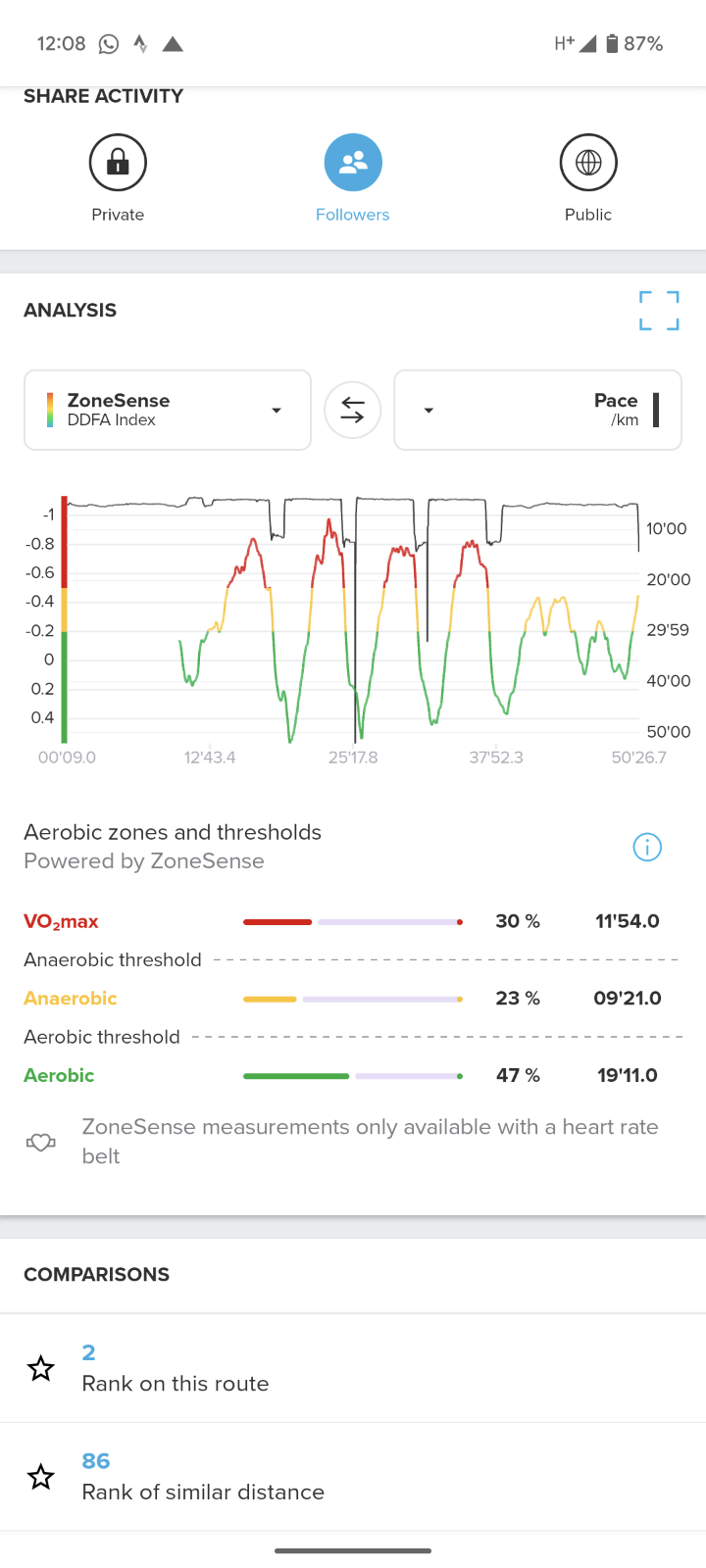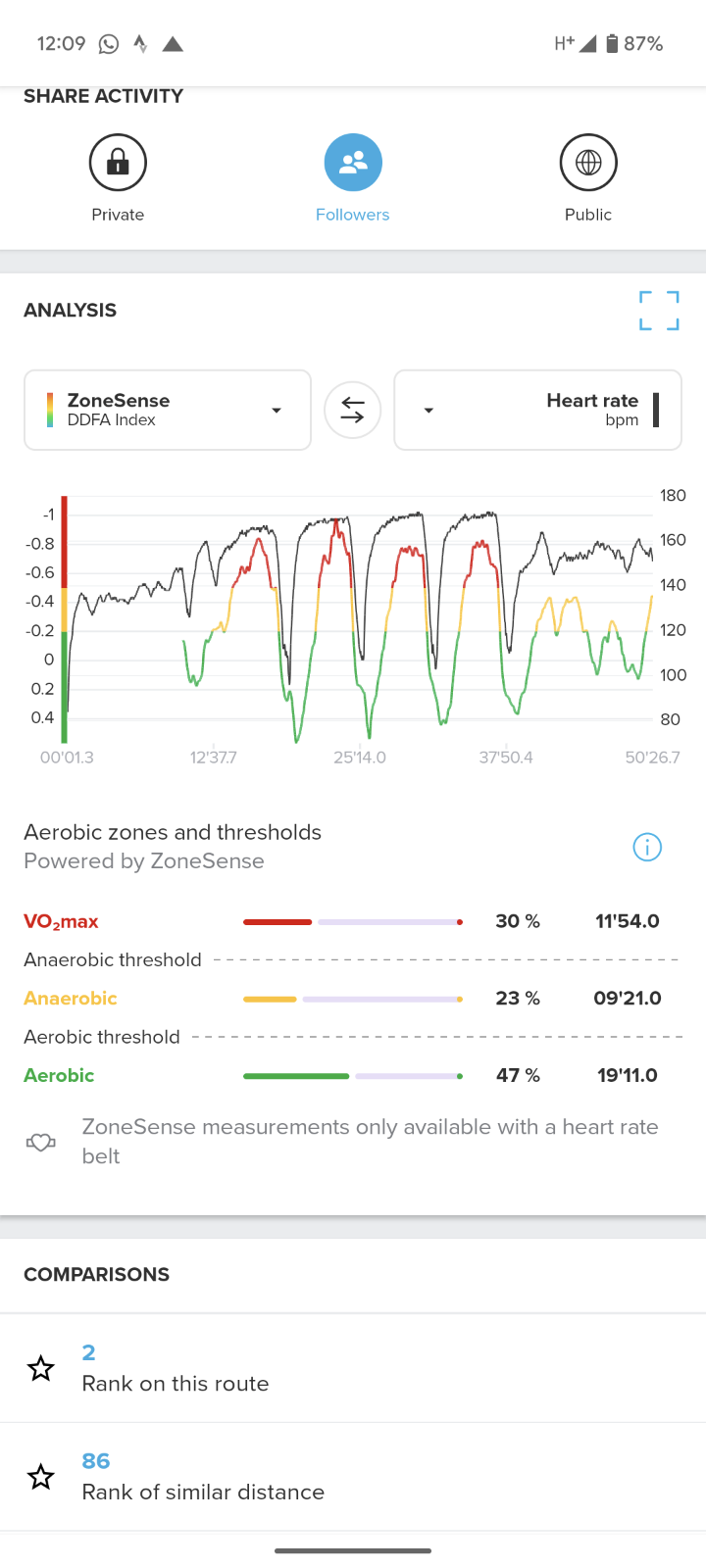Suunto ZoneSense
-
@cosme-costa said in Suunto ZoneSense:
In the Spanish forum there is more information than here with some doctors explaining cases of use of ZS that are very interesting.
It would be great to have an english translation of that here

-
@halajos Yes indeed!
Check the YouTube channel of Luis del Aguila, he is a sport Dr. that uses ZS, you can use the automatic subtitles.
-
@cosme-costa Thanks a lot for your insights!
However, to me the meaning of this sentence is unclear: “To have a good starting data in general, the first 3/4 runs with ZS, the whole run, should be very easy, but eventually everything will align if you do not do that.”. Would you mind rephrasing?
Additionally, why do you state that one shouldn’t try to match ZS and HR? I’m under the impression that this is exactly what Suunto is doing in the second screenshot I provided (even suggesting to change your HR zones based on ZS data). I fully got the idea, that on one day my aerob threshold could be at 140 bpm, the next day it could be at 150 bpm (due to fatigue, stress, sleep quality, etc). However, comparing HR and ZS still makes a lot of sense to me.
And finally, green is Z1&2, not yellow. So when trying to stay in Z2, I need to be within green, do you agree? And as you identified correctly, it was a slow pace. However, in reality, me trying to do a Z2 endurance training run, I would most likely had to run even slower (at a HR of around 140, maybe 150), not faster;). You see, I‘m only starting to run, haha
-
@halajos use the EDGE Browser. It translates all websites in language you are set.
-
@cosme-costa said in Suunto ZoneSense:
@VoiGAS Sorry, maybe I wasn’t clear enough, you have to stop and save the warm up. I guess a multisport should do too but as far as I know ZS distinguish among sports, so not the same values for biking than for running, I do not know if between running and trail running it consider them different sports.
Thank you, I’ll try it that way!
-
@tschogo green is z1&2 yellow z3&4 red z5
-
@Mountain yes exactly. I tried to (and did, according to ZS) stay mostly in Z2. Even though this can‘t be true with my HR sometimes well above 160 (and me only starting to run somewhat methodically, i.e I‘m not a trained runner). That‘s basically why I‘m (still) confused.
-
@tschogo that’s the point why ZoneSense doesn’t work.
-
@tschogo i don’t think thats „exactly“
 . Your HR zones are fixed values, that may or may not correspond to your actual aerobic/anaerobic state for that day. What was „green“ last week, (when the weather was colder, you had no cold, had no alcohol the night before etc. ) could be yellow today, (when it‘s warmer, you had 3 beers the night before and your nose is running faster then your feet
. Your HR zones are fixed values, that may or may not correspond to your actual aerobic/anaerobic state for that day. What was „green“ last week, (when the weather was colder, you had no cold, had no alcohol the night before etc. ) could be yellow today, (when it‘s warmer, you had 3 beers the night before and your nose is running faster then your feet  ). Also your HR Max could be wrong etc. I could recommend to run with Zonesense and trust the process
). Also your HR Max could be wrong etc. I could recommend to run with Zonesense and trust the process 
-
@tschogo Heart rate doesn’t always correlate with ZoneSense. For example, sometimes I run in full sunlight—I’m in Brazil, and the sun is extremely intense. With a heart rate of 120, I can shift into the anaerobic yellow zone simply due to the heat. The algorithm takes many more factors into account than just heart rate.
-
@Mountain the algorithm does take into account only the heart rate variability (and does some crazy correlation based maths to it).
The rest is happening in your body, which reacts to different stressors (like heat, muscle fatigue etc). Zone sense is just looking at the result -
@Egika Exactly, and HRV is influenced by so many factors I never would have expected.
-
@Mountain Same here. Can’t run nearly HFmax and ZoneSense shows me green. Nonsens at this time. ZoneSense isn’t really work at this moment.
-
@Sportsfreund I think you do not understand the metric.
First, what is your HRmax? How have you calculated it? It doesn’t matter, neither the number. ZS is related to the metabolism. With HR, when you arrive at Z5 you say that you are in Z5, with only one beat, being tired or not. But with ZS, you need to be some time in there, because you need to be really there in yellow or red, I mean you can run 200 m at max, your HR will be Z5 but metabolically you aren’t there, but instead run 5 minutes at max, then you will see the red. Instead of saying that it doesn’t work you should put here some graphs and values and probably someone can help you.
Here you have my run from today, ZS totally matches my feelings. As clarification, after the WU and before the intervals I tried to enter in yellow (recommendation for a good WU before intervals) , due the time that I had to do the run I couldn’t do it properly but you can see that my pace was the same than in the intervals but I was in ZS green and that is pretty logical because I wasn’t metabolically “tired” yet.


-
@cosme-costa for example. Do you know what a CooperTest is?
While all the Test, inclusive warm up and cool down the graph was in green zone. After 10min in cool down phase the graph switched into the colored zones. Not in time only afterwards. -
@Sportsfreund ZoneSense functions exceptionally well; however, it appears that understanding its mechanics presents a certain challenge.
-
@Sportsfreund Of course I know what a Cooper test is! And if you know it you would agree with me that its científic value is, lets say… an approach as could be HRmax=220-age. I only take into account Cooper test as an comparison to see the evolution. If you have a very good aerobic base it could be that you did the test in green (ZS) or you are thinking that you have pushed but you haven’t.
Which watch do you use? Which were the values in the watch? I’ve read that could be some delay between the values in the watch and the app, that what you see in the app is not what you see in the watch, the app is like “delayed”. This theoretically is solved in iOS app but not yet in Android app, will be in next beta (info from the Spanish Forum)
-
@cosme-costa No no. As I wrote. I run very nearly hfmax (I know this value from former Medizin Test)
The thing is that the green graph first switch backwards into the other valuecolors. Not in time.
You know what I mean. It does not work realtime it is very delayed.
Happy that your watches work in realtime.
I use the vertical.
-
@Sportsfreund I use a Vertical too, so we should have the same behaviour.
I did a test lab some time ago, and the values from that test lab are not valid now. The values from your test lab are only valid the day that you did the test. One of the nice things of ZS is that it detects if you had a bad night or you are becoming ill or you are very rested.@Sportsfreund said in Suunto ZoneSense:
As I wrote. I run very nearly hfmax (I know this value from former Medizin Test)
But how much time? You can reach your max HR for very small time and you are not metabolically in red zone.
-
@cosme-costa While the Cooper test time. You know what Cooper test is?
10 min warmup, 12 minutes run with all you have, 20 min cool down.
While all the time the graph shows green. In the last minutes of cool down it switched delayed backwards into the other zones.
BACKWARDS !!! - not in time. You know?And it is not true that all verticals are equal.
A lot of users at this time have a lot of issues with the actual Software. Mine don’t has any issues like this. So you can not compare a vertical with a vertical.PS: monitored this delay also in other long fast trainings. Example 10 km in HR 85%. Same here, all green and in the last minutes the Graph changes backwards in yellow areas.
So now belief me or not.
